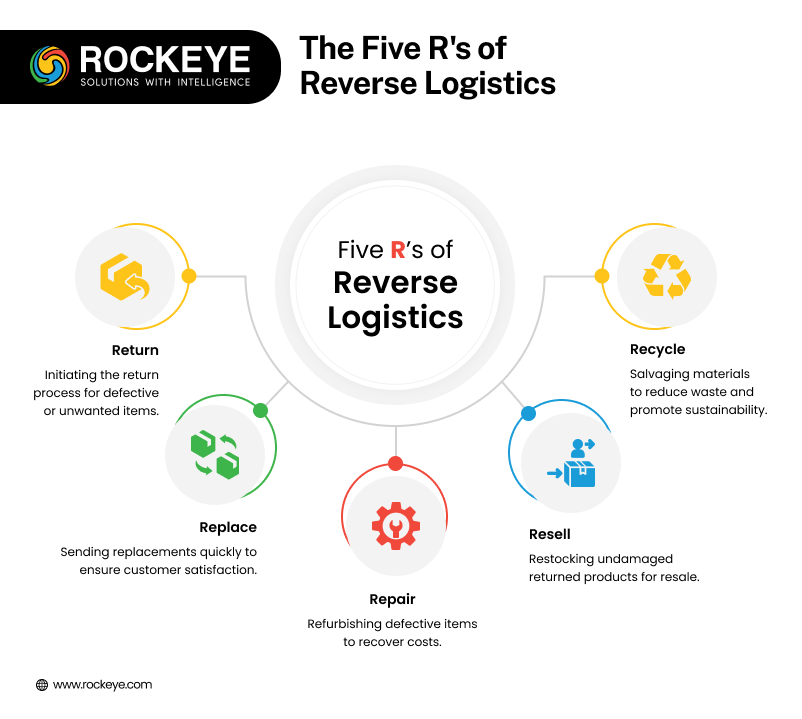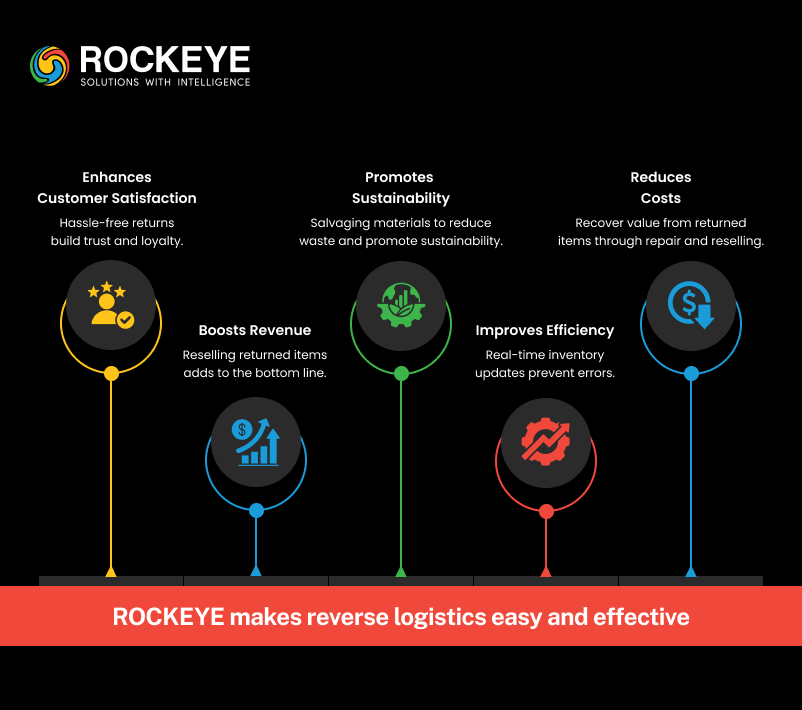While speedy delivery is a must to satisfy customers, what’s also important is to speedily solve their grievances after they receive their order. If customers aren’t satisfied with the product, they will request to return it.
This is where reverse logistics come into play. Read further to understand the concept in detail.
What is reverse logistics?
Most of us are already aware of forward logistics, where the goods are transferred from the manufacturers to consumers. Manufacturers sell to wholesalers in bulk, retailers buy the goods from wholesalers and disperse them to the end consumers.
But in reverse logistics, the items move back through the supply chain software, that is, from customers to the resellers and manufacturers. Reverse logistics do not just help with retrieving the items from customers but also recover the value from the returned items.
Five R’s of reverse logistics
The reverse logistics process begins when the customer places a request for a return. After receiving the request, you can approve/reject it, schedule the shipment for collection, and sanction the refund once the item is collected.
Once you receive the items, you need to decide what should be done. This requires a thorough inspection of the product’s quality. Is it in good condition? If yes, it can be resold. If the product is defective, you can decide to either repair or recycle it.
The components of the reverse logistics processes can be summed up in five Rs. These are return, replace, repair, resell, and recycle. Let’s understand each “R” in detail.

1. Returns
Returns are the first step in the reverse logistics process, where customers return what they ordered. There can be plenty of reasons to return items, such as product defects, failure to meet expectations, or simply receiving the incorrect item.
Providing hassle-free returns is a sure way to improve customer satisfaction. It is important to have visibility over your returns to ensure they are inspected and processed correctly. It’s best to keep the returned items separate in the warehouse, so they don’t get mixed up and sent to other customers.
Returns aren’t always initiated by the customers. Sometimes, the brand can recall its items. For instance, maybe the product violates a governmental regulation or contains a manufacturing defect that could be potentially harmful.
Because processing returns costs money, try to reduce them. Selling good quality products, avoiding misleading advertisements, and using proper packing (to reduce transit damage) can help in lowering your product returns.
2. Replacement
Usually, customers expect to receive a refund after returning the ordered items. If the product was defective and the customer approves, sending a replacement can save you money and protect your reputation with the customer.
Also Read: The 5S method of warehouse management explained
You don’t want your customers to wait for long to receive the replacement after returning the orders. To sweeten the pot, you can arrange the pickup and delivery at the same time. This way, the customer can exchange the old items with the new ones.
3. Repair
In case the customer voluntarily returns an item due to minor defects, you can repair and return the item or resell it as a refurbished product. Refurbishment is widely practiced in the electronics industry, where you may be familiar with refurbished phones, earphones, and televisions. Refurbished items are usually priced lower than original items, making it a win-win situation for both parties — customers pay less, and businesses get to recover some of their costs.

4. Reselling
Products that require repackaging are the easiest to deal with. These are usually good quality products that got returned because they didn’t meet the customers’ expectations. Think of it this way, suppose you accidentally shipped a black shirt instead of a brown one. Obviously, it will get returned, but that doesn’t imply the shirt has some defect that makes it unfit for reselling. You can ship that correctly to someone who ordered a black shirt.
Upon receiving the items, you should thoroughly recheck the products to ascertain any damage by the customer, which may require repairs. If not, you can add it to your existing inventory, ready for selling. Reselling enables you to generate revenue from returns.
5. Recycling
Customers appreciate brands that put environmental sustainability at the forefront. Recycling helps in waste management arising from the returns. Electronic items (like smartphones) have a life cycle, and once it reaches its end, it needs to be scrapped. Still, electronics items can be salvaged to retrieve important minerals like copper and titanium, which can be reused to make other components. With smarter recycling, brands can recover some of the cost incurred to manage the returns.

Q1: Why is promptly resolving customer issues after delivery just as crucial as fast shipping?
A : While speedy delivery is a must to satisfy customers, what’s also important is to quickly address their concerns once they receive their order. If they’re not happy with the product, they will request to return it.
Q2: Can you briefly explain reverse logistics and how it differs from forward logistics?
A: In reverse logistics, items move back through the supply chain—from customers to resellers and manufacturers. Reverse logistics not only retrieves the products from customers but also helps recover the value from those returned goods.
Q3: What are the five R’s of reverse logistics?
A : The main elements of the reverse logistics process can be summed up by five R’s: return, replace, repair, resell, and recycle. This sequence starts when a customer requests a return and ends with the decision about whether the product should be resold, repaired, or recycled.
Q4: How can businesses reduce the cost associated with frequent returns?
A: Because returns can be expensive to process, it’s best to minimize them. Selling high-quality products, avoiding misleading ads, and using proper packaging (to prevent transit damage) are effective ways to lower the number of returns.
Q5: When should a replacement be considered instead of a refund?
A: If the product is defective and the customer agrees, sending a replacement can save costs and maintain a good relationship with the buyer. It’s also helpful to schedule pickup and delivery at the same time so the customer can exchange the item in one go.

